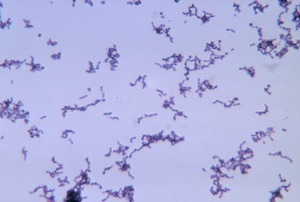Propionibacteria
| Propionibacteria | ||||||||||||
|---|---|---|---|---|---|---|---|---|---|---|---|---|

Propionibacterium acnes |
||||||||||||
| Systematics | ||||||||||||
|
||||||||||||
| Scientific name | ||||||||||||
| Propionibacterium | ||||||||||||
| Orla-Jensen emend in 1909. Charfreitag et al. 1988 |
Propionibacteria , also known as propionic acid bacteria , are gram-positive rod- shaped bacteria that belong to the natural microbial flora of the skin and cause cheese holes in some types of cheese. These arise from the CO 2 formed during propionic acid fermentation . Propionibacterium species live anaerobically to aerotolerant , have a high GC content and are obligatory, mostly secondary fermenters. They place very high demands on their nutrient sources (amino acids, purines ...) and generally grow very slowly and only in special places. Under certain conditions, they can be involved in infections such as acne vulgaris .
metabolism
The propionic acid as a metabolic end product is determined by the methylmalonyl-CoA pathway formed. If the energy yield from fermentation metabolism, also known as substrate chain phosphorylation , is not sufficient, the breakdown of the carbon source is additionally coupled with ion pumps that build up a hydrogen or sodium gradient on the cytoplasmic membrane. In this way, the sodium gradient that has built up is used for the synthesis of ATP and the energy yield from the utilization of the substrate is increased.
Systematics
The genus Propionibacterium belongs to the family of Propionibacteriaceae , which together with the family of Nocardioidaceae forms the subordination of Propionibacterineae . Several subordinates, such as B. the Actinomycineae , Micrococcineae and Streptomycineae together form the order of Actinomycetales , which is in the division ( Divisio or Phylum ) of Actinobacteria . In addition to Propionibacterium as a type genus , the Propionibacteriaceae family also includes other genera.
Propionibacterium was first described in 1909 by Sigurd Orla-Jensen , the description was given in 1988 by Charfreitag et al. expanded. The genus includes the following species and subspecies (as of 2014):
- Propionibacterium acidifaciens Downes & Wade 2009
- Propionibacterium acidipropionici corrig. Orla-Jensen 1909
- Propionibacterium acnes (sic) ( Gilchrist 1900) Douglas & Gunter 1946
- Propionibacterium australiense Bernard et al. 2002
- Propionibacterium avidum (Eggerth 1935) Moore & Holdeman 1969
- Propionibacterium cyclohexanicum Kusano et al. 1997
- Propionibacterium freudenreichii van Niel 1928
- Propionibacterium freudenreichii subsp. freudenreichii (van Niel 1928) Moore & Holdeman 1970
- Propionibacterium freudenreichii subsp. shermanii (van Niel 1928) Holdeman & Moore 1970
- Propionibacterium granulosum (Prévot 1938) Moore & Holdeman 1970
- Propionibacterium jensenii van Niel 1928
- Propionibacterium microaerophilum Koussémon et al. 2001
- Propionibacterium propionicum corrig. (Buchanan & Pine 1962) Charfreitag et al. 1988
- Propionibacterium thoenii van Niel 1928
Medical importance
Proprionibacterium species can cause infections after joint replacements, especially in the shoulder joint, as well as infections after neurosurgery.
literature
- Martin Dworkin, Stanley Falkow, Eugene Rosenberg, Karl-Heinz Schleifer , Erko Stackebrandt (eds.): The Prokaryotes , 3rd edition, Vol. 3: Archaea. Bacteria: Firmicutes, Actinomycetes . Springer Verlag, New York 2006, ISBN 978-0-387-25493-7 (print), ISBN 978-0-387-30743-5 (online)
Individual evidence
- ^ A b Jean Euzéby, Aidan C. Parte: Genus Propionibacterium. In: List of Prokaryotic names with Standing in Nomenclature ( LPSN ). Retrieved August 10, 2014 .
- ^ Marianne Abele-Horn: Antimicrobial Therapy. Decision support for the treatment and prophylaxis of infectious diseases. With the collaboration of Werner Heinz, Hartwig Klinker, Johann Schurz and August Stich, 2nd, revised and expanded edition. Peter Wiehl, Marburg 2009, ISBN 978-3-927219-14-4 , p. 266 ( Propionibacterium spp. ).